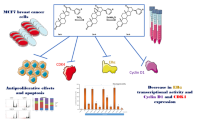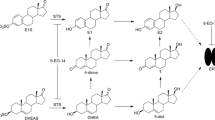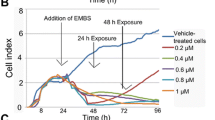Summary
The sensitivity of breast neoplasms to hormonal control provides the basis of novel investigational treatments with steroidal alkylators. An androsterone D-lactam steroidal ester, the 3β-hydroxy-13α-amino-13,17-seco- 5α-androstan-17-oic-13,17-lactam, p-bis(2-chloroethyl)amino phenyl acetate (lactandrate) was synthesized and tested for antitumor activity against six human breast cancer cell lines in vitro and against two murine and one xenograft mammary tumors in vivo. A docking study on the binding interactions of lactandrate with the ligand-binding domain (LBD) of estrogen receptor-alpha (ERα) was inquired. In vitro testing of lactandrate cytostatic and cytotoxic activity was performed on T47D, MCF7, MDA-MB-231, BT-549, Hs578T, MDA-MB-435 breast adenocarcinoma human cell lines. In vivo testing was performed on two murine mammary tumors, the MXT tumor and CD8F1 adenocarcinoma, as well as on human mammary carcinoma MX-1 xenograft. Molecular modeling techniques were adopted to predict a possible location and interaction mode of the molecule into LBD. Lactandrate induced significantly high antitumor effect against all tested in vitro and in vivo models. The cell lines with positive ER expression found to be significantly more sensitive to lactandrate. Moreover, lactandrate found to be positioned inside the binding cavity with its steroidal moiety, whilst the alkylating moiety protrudes out of receptor’s pocket. Lactandrate produced important anticancer activity on breast cancer in vitro and in vivo. Some correlation between ER and lactandrate effect was demonstrated. Docking studies provide the basis for the structure-based design of improved steroidal alkylating esters for the treatment of estrogen-related cancers.
Similar content being viewed by others
Abbreviations
- AF-2:
-
activation function 2
- AWC:
-
average mice weight change
- CR:
-
complete tumor regression rate
- DMSO:
-
dimethyl sulfoxide
- ER:
-
estrogen receptor
- GI50:
-
50% growth inhibition
- hERα:
-
human estrogen receptor alpha
- IC50:
-
50% in vitro cytotoxicity
- i.p.:
-
intra-peritoneal
- LBD:
-
ligand-binding domain
- MTD:
-
maximum tolerated dose
- PKC:
-
protein kinase C
- PR:
-
partial tumor regression rate
- TGI:
-
total growth inhibition
- TFS:
-
tumor-free survivors
- TI:
-
tumor inhibition
- TW:
-
tumor weight
- %T/C:
-
% median lifespan change of treated animals (T) over the control (C)
References
Wong ZW, Ellis MJ, First-line endocrine treatment of breast cancer: aromatase inhibitor or antioestrogen? Br J Cancer 90: 20–25, 2004
Mouridsen HT, Rose C, Brodie AH, Smith IE, Challenges in the endocrine management of breast cancer Breast 2(Suppl): S2–19, 2003
Catsoulacos P, Politis D, Wampler GL, A new steroidal alkylating agent with improved activity in advanced murine leukemias Cancer Chemother Pharmacol 3: 67–70, 1979
Catsoulacos P, Camoutsis C, Wampler GL, Effect of a Δ5-homo-aza-steroidal ester in P388 and L1210 murine leukemias Oncology 39: 59–60, 1982
Catsoulacos P, Activity of 3β-hydroxy-13α-amino-13,17-seco-5α-androstan-17-oic-13, 17-lactam p-bis (2-chloroethyl)aminophenoxy acetate (NSC-294859) on experimental tumor and leukemia systems. Oncology 40: 290–292, 1983
Catsoulacos P, Wampler GL, Activity of 3β-hydroxy-13α-amino-13,17-seco-5α-androstan-17-oic-13,17-lactam(p-bis(2-chloroethyl)amino)-phenyl)acetate (NSC-290205) in murine solid tumors Oncology 39: 109–112, 1982
Catsoulacos P, Further studies on the anti-neoplastic activity of 3β-hydroxy-13α-amino-13,17-seco-5α-androstan-17-oic-13,17-lactam(p-bis(2-chloroethyl)amino)phenyl)acetate (NSC-290205). Cancer Lett 22: 199–202, 1984
Wall ME, Abernethy SG, Carroll JFI, Taylor DJ, The effects of some steroidal alkylating agents on experimental animal mammary tumor and leukemia systems J Med Chem 12: 810–818, 1969
Wampler GL, Catsoulacos P, Antileukemic effect of homo-aza-steroidal-ester of [p-[bis(2-chloroethyl)amino]acetic acid Cancer Treat Rep 61: 37–41, 1977
Tsai M-J, O’Malley BW, Molecular mechanisms of action of steroid/thyroid receptor superfamily members Annu Rev Biochem 63: 451–486, 1994
Beato M, Sanchez-Pacheco A, Interaction of steroid hormone receptors with the transcription initiation complex Endocr Rev 17: 587–609, 1996
Shiau AK, Barstad D, Loria M, Cheng L, Kushner PJ, Agard DA, Greene GL ,The structural basis of estrogen receptor/coactivator recognition and the antagonism of this interaction by tamoxifen Cell 95: 927–937, 1998
Catsoulacos P, Boutis L, Aza-steroids. Beckmann rearrangement of 3β-acetoxy-5α-androstan-17-one oxime acetate with boron fluoride. Alkylting agents. Chim Ther 8: 215–217, 1973
Finlay GJ, Wilson WR, Baguley BC, Comparison of in vitro activity of cytotoxic drugs towards human carcinoma and leukaemia cell lines Eur J Cancer Clin Oncol 22: 655–662, 1986
Alley MC, Scudiero DA, Monks A, Hursey ML, Czerwinski MJ, Fine DL, Abbott BJ, Mayo JG, Shoemaker RH, Boyd MR, Feasibility of drug screening with panels of human tumor cell lines using a microculture tetrazolium assay Cancer Res, 48: 589–601, 1988
Boyd MR, Paull KD, Some practical considerations and applications of the National Cancer Institute in vitro anticancer drug discovery screen Drug Devel Res 34: 91–109, 1995
Francisco J, Pauwels Ο, Simon S, Gasperin P, Van Houtte P, Pasteels JL, Kiss R, Computer-assisted morphonuclear characterization of radiotherapy-induced effects in MXT mouse mammary adenocarcinomas surviving earlier radiotherapy Int J Radiat Oncol Biol Phys 32: 409–419, 1995
Danguy A, Kiss R, Leclercq G, Heuson JC, Pasteels JL, Morphology of MXT mouse mammary tumors. Correlation with growth characteristics and hormone sensitivity Eur J Cancer Clin Oncol 22: 69–76, 1986
Martin DS, Fugmann RA, Stolfi RL, Hayworth PE, Solid tumor animal model therapeutically predictive for human breast cancer Cancer Chemother Rep 5: 89–109, 1975
Goldin A, Vendi JM, MacDonald JS, Muggia FM, Henney JE, DeVita VT Jr, Current results of the screening program at the Division of Cancer Treatment, National Cancer Institute Eur J Cancer, 17: 129–142, 1981
Stolfi RL, Martin DS, Fugmann RA, Spontaneous mutine mammary adenocarcinoma: model system for evaluation of combined methods of therapy Cancer Chemother Rep 55: 239–251, 1971.
NIH Principles of laboratory animal care. NIH publication 85: 23, 1985
Workman P, Twentyman P, Balkwill F, Balmain A, Chaplin D, Double J, Embleton J, Newell D, Raymond R, Stables J, Stephens T, Wallace J, United Kingdom Co-ordinating Committee on Cancer Research (UKCCCR) guidelines for the welfare of animals in experimental neoplasia (second edition) Br J Cancer 77: 1–10, 1998
Carosati E, Sciabola S, Gabriele C, Hydrogen bonding interactions of covalently bonded fluorine atoms: from crystallographic data to a new angular function in the GRID force field J Med Chem 47: 5114–5125, 2004
Goodford PJ, 1985 A computational procedure for determining energetically favourable binding sites on biologically important macromolecules J Med Chem 28: 849–857
Brozowski AM, Pike ACW, Dauter Z, Hubbard RE, Bonn T, Engström O, Öhman L, Greene GL, Gustafsson JÅ, Carlquist M, 1997 Molecular basis of agonism and antagonism in the oestrogen receptor Nature 389: 753–758
Boyer S, Zamora I, New methods in predicting metabolism J Comput-Aided Mol Des 16: 403–413, 2002
Zamora I, Afzelius L, Cruciani G, Predicting drug metabolism: a site of metabolism prediction tool applied to the cytochrome P450 2C9 J Med Chem 46: 2313–2324, 2003
Boobis A, Gundert-Remy U, Kremers P, Macheras P, Pelkonen O, In silico prediction of ADME and pharmacokinetics. Report of an expert meeting organised by COST B15 Eur J Pharm Sci 17: 183–193, 2002
Wrighton SA, Schuetz EG, Thummel KE, Shen DD, Korzekwa KR, Watkins PB, The human CYP3A subfamily: practical considerations Drug Metab Rev 32: 339–361, 2000
Guengerich FP, 2001 Common and uncommon cytochrome P450 reactions related to metabolism and chemical toxicity Chem Res Toxicol 14: 611–650
Crivori P, Zamora I, Speed B, Orrenius C, Poggesi I, Model based on GRID-derived descriptors for estimating CYP3A4 enzyme stability of potential drug candidates J Comput-Aid Mol Des 18: 155–166, 2004
Renaud J, Bischoff SF, Buhl T, Floersheim P, Fournier B, Halleux C, Kallen J, Keller H, Schlaeppi J-M, Stark W, Estrogen receptor modulators: identification and structure-relationships of potent ER-selective tetrahydroisoquinoline ligands J Med Chem 46: 2945–2957, 2003
Kekenes-Huskey PM, Muegge I, Rauch M, Gust R, Knapp E-W, A molecular docking study of estrogenically active compounds with 1,2-diarylethane and 1,2-diarylethene pharmacophores Bioorg Med Chem 12: 6527–6537, 2004
Jones KL, Buzdar AU, Jones KL, Buzdar AU, A review of adjuvant hormonal therapy in breast cancer Endocr Relat Cancer 11: 391–406, 2004
Leclercq G, Devleeschouwer N, Pairas G, Camoutsis C, Catsoulacos P, Effect of an homo-aza-steroid on estrogen receptor Meth Find Exp Clin Pharmacol 5: 365–367, 1983
Cho W-J, Min SY, Le TN, Kim TS, Synthesis of new 3-arylsoquinolinamines: effect on topoisomerase I inhibition and cytotoxicity Bioorg Med Chem Lett 13: 4451–4454, 2003
De la Fuente JA, Manzanaro S, Martin MJ, de Quesada TG, Reymundo I, Luengo SM, Gago F, Synthesis, activity, and molecular modeling studies of novel human aldose reductase inhibitors based on a marine natural product J Med Chem 46: 5208–5221, 2003
Sarno S, de Moliner E, Ruzzene M, Pagano MA, Battistuta R, Bain J, Fabbro D, Schoepfer J, Elliott M, Furet P, Meggio F, Zanotti G, Pinna LA, Biochemical and three-dimensional-structural study of the specific of protein kinase CK2 by [5-oxo-5,6-dihydroindolo-(1,2-a)quinazolin-7-yl]acetic acid (IQA) Biochem J 374: 639–646, 2003
Tzukerman MT, Esty A, Santiso-Mere D, Danelian D, Parker MG, Stein RB, Pike JW, McDonnell DP, Human estrogen receptor transactivational capacity is determined by both cellular and promoter context and mediated by two functionally distinct intramolecular regions Mol Endocrinol 8: 21–30, 1994
Kabara JJ, Holzschu DL, Catsoulacos P, Structure function activity of azasterols and nitrogen containing steroids Lipids 11: 7555–7562, 1976
Tsuchiya Y, Nakajima M, Yokoi T, Cytochrome P450-mediated metabolism of estrogens and its regulation in human Cancer Lett 20: 1–10, 2004
Torimoto N, Ishii I, Hata M, Nakamura H, Imada H, Ariyoshi N, Ohmori S, Igarashi T, Kitada M, 2003 Direct interaction between substrates and endogenous steroids in the active site may change the activity of cytochrome P450 3A4 Biochemistry 42: 15068–15077
Szklarz GD, Halpert JR, 1997 Molecular modeling of cytochrome P450 3A4 J Comput Aided Mol Des 1: 265–272
Papageorgiou A, Ivanov IG, Markov GG, Koliais SI, Boutis L, Catsoulacos P, Interaction of homo-aza-steroidal ester of [p-[bis-(2-chloroethyl) amino] acetic acid (ASE) with DNA of Ehrlich ascites tumor cells FEBS Lett 153: 194–198, 1983
Shepherd RE, Huff K, McGuire WL, Brief communication: estrogen receptor interaction with antitumor agent estradiol mustard J Nat Cancer Inst 53: 895–897, 1974
Kubota T, Kawamura E, Suzuki T, Yamada T, Toyoda H, Miyagawa T, Kurokawa T,Antitumor activity and pharmacokinetics of estra-1,3,5 (10)-triene-3,17 beta-diol, 3-benzoate, 17-((4-(4-bis(2-chloroethyl)amino)phenyl)-1-oxobutoxy) acetate) (Bestrabucil) in human tumor xenografts serially transplanted into nude mice Jpn J Clin Oncol 16: 357–564, 1986
Catsoulacos P, Catsoulacos D, Antitumor activity of homo-aza-steroidal esters of p-N,N-bis(2-chloroethyl) amino phenoxy acetic acid Anticancer Res 13: 1203–1208, 1993
Camoutsis C, Trafalis DTP, An overview on the antileukemic potential of D-homo-aza- and respective 17β-acetamido-steroidal alkylating esters Invest New Drugs 21: 47–54, 2003
Trafalis DTP, Camoutsis C, Dalezis P, Papageorgiou A, Kontos M, Karamanakos P, Giannakos G, Athanassiou AE, Antitumour effect of A- and D-lactam androgen nitrogen mustards on non-small cell lung carcinoma J BUON 9: 75–82, 2004
Ma D, Wang G, Wang S, Kozikowski AP, Lewin NE, Blumberg PM, Synthesis and protein kinase C binding activity of benzolactam-V-7 Bioorg Med Chem Lett 9: 1371–1374, 1999
Endo Y, Shimazu M, Fukasawa H, Driedger PE, Kimura K, Tomioka N, Itai A, Shudo K, Synthesis computer modelling and biological evaluation of novel protein kinase C agonists based on a 7-membered lactam moiety Bioorg Med Chem Lett 9: 173–178, 1999
Endo Y, Yokohama A, Role of the hydrophobic moiety of tumor promoters. Synthesis and activity of 2-alkylated benzolactams Bioorg Med Chem Lett 10: 63–66, 2000
Trafalis DTP, Camoutsis C, Karamanakos P, Arvanitis A, Tegou E, Ziras N, Athanassiou AE, Preclinical evaluation of the homo-aza-steroidal ester: 13β-hydroxy-13α-amino-13,17-seco-5α-androstan-17-oic-13,17-lactam-p-bis(2-chloro ethyl) aminophenoxy acetate for the treatment of malignant melanoma J BUON 8: 333–339, 2003
Catsoulacos P, Politis D, Wampler GL, Antitumor activity of homo-aza-steroidal esters of [p-bis(2-chloroethyl)amino]phenyl]acetic acid [p-bis(2-chloroethyl)amino] phenyl]butyric acid Cancer Chemother Pharmacol 10: 129–132, 1983
Catsoulacos P, Camoutsis C, Papageorgiou A, Adamiak-Margariti E, Cytostatic effect of homo-aza-steroidal esters in vivo and in vitro structure–activity relationships Anticancer Res 12: 1617–1620, 1992
Dalmases P, Gomez-Belinchon JI, Bonet J-J, Giner-Sorolla A, Schmid FA, Antineoplastic agents II. A nitrogen mustard derivative of N-methylated steroidal lactam Eur J Med Chem 18: 541–543, 1983
Dalmases P, Cervantes G, Quintana J, Bonet J-J, Antineoplastic agents. V. Nitrogen mustards of systematically modified steroidal ring A lactams Eur J Med Chem 19, 465–467, 1984
Catsoulacos P, Papageorgiou A, Margariti E, Mourelatos D, Mioglou E, Comparison of current alkylating agents with a homo-aza-steroidal ester for antineoplastic activity Oncology 51: 74–78, 1994
Tiersten AD, Nelsen C, Talbot S, Vahdat L, Fine R, Troxel A, Brafman L, Shriberg L, Antman K, Petrylak DP, A phase II trial of docetaxel and estramustine in patients with refractory metastatic breast carcinoma Cancer 97: 537–544, 2003.
Ζelek L, Βarthier S, Riofrio M, Sevin D, Fizazi K, Spielmann M, Single-agent estramustine phosphate (EMP) is active in advanced breast cancer after failure with anthracyclines and taxanes Ann Oncol 12: 1265–1268, 2001
Kubota T, Abe O, Izuo M, Watanabe H, Enomoto K, Ohsawa N, Kuno K, A phase II multi-institutional study of estra-1,3,5(10)-triene-3,17 beta-diol, 3-benzoate, 17[[4-[4-[bis(2-chloroethyl)amino]phenyl]-1- oxobutoxy]acetate] (KM2210), a novel antitumor agent, for advanced and recurrent breast carcinoma Anticancer Res 13: 2361–2365, 1993
Kubota T, Ishibiki K, Abe O, Kosano H, Ohsawa N, Hoffman RM, Mode of action of estra-1,3,5(10)-triene-3, 17 beta-diol, 3-benzoate, 17[4-[4-[bis(2-chloroethyl) amino]phenyl]-1-oxobutoxy] acetate] (KM2210) on MCF-7 human breast tumours transplanted into nude mice Anticancer Res 13: 935–940, 1993
Acknowledgements
This work has been accomplished with the experimental and technical support of the Developmental Therapeutics Program, National Cancer Institute (NCI, USA).
We are grateful to Professor Gabriele Cruciani (Laboratory for Chemometrics, School of Chemistry, University of Perugia, Italy) for the permission to use GRID (v. 22) Linux, free of charge (www.moldiscovery.com).
This study is dedicated to the memory of Professor P. Catsoulacos and Professor G. Wampler.
Author information
Authors and Affiliations
Corresponding author
Rights and permissions
About this article
Cite this article
Trafalis, D.T., Geromichalos, G.D., Koukoulitsa, C. et al. Lactandrate: a D-homo-aza-androsterone alkylator in the treatment of breast cancer. Breast Cancer Res Treat 97, 17–31 (2006). https://doi.org/10.1007/s10549-005-9083-x
Received:
Accepted:
Published:
Issue Date:
DOI: https://doi.org/10.1007/s10549-005-9083-x




